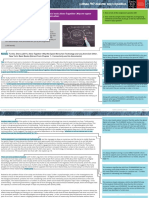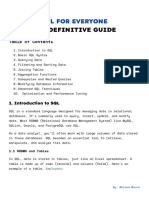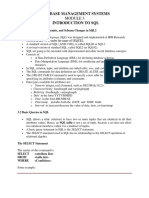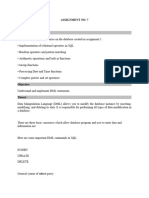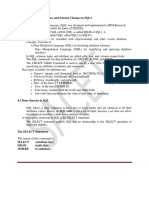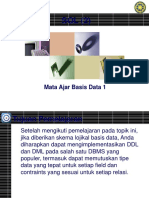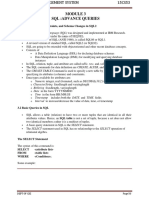Module III - Royal Babu
Module III - Royal Babu
Uploaded by
3amrithamanoj12aCopyright:
Available Formats
Module III - Royal Babu
Module III - Royal Babu
Uploaded by
3amrithamanoj12aCopyright
Available Formats
Share this document
Did you find this document useful?
Is this content inappropriate?
Copyright:
Available Formats
Module III - Royal Babu
Module III - Royal Babu
Uploaded by
3amrithamanoj12aCopyright:
Available Formats
CS208 Principles of Database Design Module III MESCE Kuttipuram
Contents:
Structured Query Language (SQL): Basic SQL Structure, examples, Set operations, Aggregate Functions, nested
sub-queries (Reading: Elmasri Navathe, Ch. 4 and 5.1) Views, assertions and triggers (Reading: Elmasri Navathe,
Ch. 5.2-5.3, Optional reading: Silbershatz, Korth Ch. 5.3).
Structured Query Language (SQL)
Basic SQL Structure
Statements used for data definitions, queries, and updates (both DDL and DML). Table, Row, and
Column used for relational model terms Relation, Tuple, and Attribute.
Examples
Department of Information Technology 1 Prof Lino Abraham Varghese
CS208 Principles of Database Design Module III MESCE Kuttipuram
1. Retrieve the birthdate and address of the employee whose name is 'John B. Smith'.
2. Retrieve the name and address of all employees who work for the 'Research' department.
3. For every project located in 'Stafford', list the project number, the controlling department
number, and the department manager's last name, address, and birthdate
4. For each employee, retrieve the employee's name, and the name of his or her immediate
supervisor.
5. Retrieve the SSN values for all employees.
6. Make a list of all project numbers for projects that involve an employee whose last name is
'Smith' as a worker or as a manager of the department that controls the project.
7. Retrieve the name and address of all employees who work for the 'Research' department with
nested queries
8. Retrieve the name of each employee who has a dependent with the same first name as the
employee.
9. Retrieve the name of each employee who works on all the projects controlled by department
number 5.
10. Retrieve the name of each employee who has a dependent with the same first name as the
employee.
11. Retrieve the names of employees who have no dependents.
12. Retrieve the social security numbers of all employees who work on project number 1, 2, or 3.
13. Find the maximum salary, the minimum salary, and the average salary among all employees.
14. Find the maximum salary, the minimum salary, and the average salary among employees who
work for the 'Research' department.
15. Retrieve the total number of employees in the company
16. Retrieve the number of employees in the 'Research' department
17. For each project, retrieve the project number, project name, and the number of employees
who work on that project.
18. Retrieve all employees whose address is in 'Houston,TX'.
19. Retrieve all employees who were born during the 1950s.
20. Show the effect of giving all employees who work on the 'ProductX' project a 10% raise.
21. Retrieve a list of employees and the projects each works in, ordered by the employee's
department, and within each department ordered alphabetically by employee last name.
Department of Information Technology 2 Prof Lino Abraham Varghese
CS208 Principles of Database Design Module III MESCE Kuttipuram
Set Operations
The set operations apply only to union compatible relations; the two relations must have the same
attributes and the attributes must appear in the same order. SQL does not automatically eliminate
duplicate tuples in the results of queries. SQL has directly incorporated some of the set operations
from mathematical set theory, which are also part of relational algebra. They are:
UNION(set union):
Make a list of all project numbers for projects that involve an employee whose last name is ‘Smith’,
either as a worker or as a manager of the department that controls the project.
EXCEPT (difference):
SELECT FNAME, LNAME
FROM EMPLOYEE
WHERE NOT EXISTS
( (SELECT PNUMBER
FROM PROJECT
WHERE DNUM=5)
EXCEPT
(SELECT PNO
FROM WORKS_ON
WHERE SSN=ESSN) );
The first subquery (which is not correlated) selects all projects controlled by department 5, and the
second subquery (which is correlated) selects all projects that the particular employee being
considered works on. If the set difference of the first subquery MINUS (EXCEPT) the second
subquery is empty, it means that the employee works on all the projects and is hence selected.
INTERSECT (intersection):
To find the set of all courses taught in the Fall 2009 as well as in Spring 2010
(SELECT COURSE ID
FROM SECTION
WHERE SEMESTER = ’FALL’ AND YEAR= 2009)
INTERSECT
(SELECT COURSE ID
FROM SECTION
WHERE SEMESTER = ’SPRING’ AND YEAR= 2010);
The relations resulting from these set operations are sets of tuples; that is, duplicate tuples are
eliminated from the result. Corresponding multiset operations: UNION ALL, EXCEPT ALL,
INTERSECT ALL
Aggregate Functions
Used to summarize information from multiple tuples into a single-tuple summary. Grouping is used
to create subgroups of tuples before summarizing. Built-in aggregate functions are COUNT, SUM,
Department of Information Technology 3 Prof Lino Abraham Varghese
CS208 Principles of Database Design Module III MESCE Kuttipuram
MAX, MIN, and AVG. Functions can be used in the SELECT clause or in a HAVING clause.
NULL values discarded when aggregate functions are applied to a particular column.
GROUP BY-clause for specifying the grouping attributes, which must also appear in the SELECT-
clause
For each department, retrieve the department number, the number of employees in the department,
and their average salary.
Q20: SELECT DNO, COUNT (*), AVG (SALARY)
FROM EMPLOYEE
GROUP BY DNO
HAVING clause provides a condition on the summary information. The HAVING-clause is used
for specifying a selection condition on groups (rather than on individual tuples).
Nested sub-queries
Complete select-from-where blocks within WHERE clause of another query.
Comparison operator IN Compares value v with a set (or multiset) of values V
Evaluates to TRUE if v is one of the elements in V
Department of Information Technology 4 Prof Lino Abraham Varghese
CS208 Principles of Database Design Module III MESCE Kuttipuram
Use other comparison operators to compare a single value v
= ANY (or = SOME) operator
• Returns TRUE if the value v is equal to some value in the set V and is hence
equivalent to IN
Other operators that can be combined with ANY (or SOME): >, >=, <, <=, and <>
Correlated Nested Query
If a condition in the WHERE-clause of a nested query references an attribute of a relation declared
in the outer query , the two queries are said to be correlated. The result of a correlated nested query
is different for each tuple (or combination of tuples) of the relation(s) the outer query.
Example: Retrieve the name of each employee who has a dependent with the same first name as the
employee.
SELECT E.FNAME, E.LNAME
FROM EMPLOYEE AS E
WHERE E.SSN IN (SELECT ESSN
FROM DEPENDENT
WHERE ESSN=E.SSN
AND E.FNAME=DEPENDENT_NAME)
EXISTS is used to check whether the result of a correlated nested query is empty (contains no
tuples) or not
The six clauses in the syntax of an SQL query
Views
A view in SQL terminology is a single table that is derived from other tables. These other tables
could be base tables or previously defined views. A view does not necessarily exist in physical
form; it is considered a virtual table, in contrast to base tables whose tuples are actually stored in the
database. This limits the possible update operations that can be applied to views, but it does not
provide any limitations on querying a view.
Creating a View:
CREATE VIEW WORKS_ON1
AS SELECT FNAME, LNAME, PNAME, HOURS
FROM EMPLOYEE, PROJECT, WORKS_ON
WHERE SSN=ESSN AND PNO=PNUMBER;
Querying a View:
SELECT FNAME, LNAME
Department of Information Technology 5 Prof Lino Abraham Varghese
CS208 Principles of Database Design Module III MESCE Kuttipuram
FROM WORKS_ON1
WHERE PNAME=‘ProjectX’;
Deleting a view:
DROP VIEW WORKS_ON1;
Assertions
Assertions are use to specify additional types of constraints outside scope of built-in relational
model constraints. Specify a query that selects any tuples that violate the desired condition. Use
only in cases where it is not possible to use CHECK on attributes and domains.
For example, to specify the constraint that "the salary of an employee must not be greater than
the salary of the manager of the department that the employee works for"
Triggers
Triggers are used to specify automatic actions that database system will perform when certain
events and conditions occur. A rule in the Event-Condition-Action model has three components:
1. The event (or events) that triggers the rule: These events are usually database update operations
that are explicitly applied to the database.
2. The condition that determines whether the rule action should be executed: Once the triggering
event has occurred, an optional condition may be evaluated. If no condition is specified, the action
will be executed once the event occurs. If a condition is specified, it is first evaluated, and only if it
evaluates to true will the rule action be executed.
3. The action to be taken: The action is usually a sequence of SQL statements, but it could also be a
database transaction or an external program that will be automatically executed.
The example below shows how triggers can be used to ensure referential integrity on the time slot id
attribute of the section relation. The trigger definition specifies that the trigger is initiated after any
insert on the relation section and it ensures that the time slot id value being inserted is valid. An
SQL insert statement could insert multiple tuples of the relation, and the for each row clause in the
trigger code would then explicitly iterate over each inserted row. The referencing new row as
clause creates a variable nrow (called a transition variable) that stores the value of an inserted row
after the insertion.
create trigger timeslot check1 after insert on section
referencing new row as nrow
for each row
when (nrow.time slot id not in (
select time slot id
from time slot)) /* time slot id not present in time slot */
begin
rollback
end;
Department of Information Technology 6 Prof Lino Abraham Varghese
You might also like
- Layout3D/ Demo3D/ Sim3D/ Emulate3D 2022 Installation and Licensing Procedure (ULS)Document6 pagesLayout3D/ Demo3D/ Sim3D/ Emulate3D 2022 Installation and Licensing Procedure (ULS)Cong LiuNo ratings yet
- AAU5831 Description (3.7GHz)Document19 pagesAAU5831 Description (3.7GHz)lagierNo ratings yet
- Sample Text 3 Critical Review TurkleDocument3 pagesSample Text 3 Critical Review Turklemctgb100% (1)
- SQL Interview Questions For IBMDocument5 pagesSQL Interview Questions For IBMilakya sri50% (2)
- Solutions To Problems in Calculus of One Variable I A Maron 5Th EditionDocument2 pagesSolutions To Problems in Calculus of One Variable I A Maron 5Th EditionAbhirup Roy0% (1)
- Dbms Module 4Document25 pagesDbms Module 4disha jaipalNo ratings yet
- DBMS Scheme CIE 2 5th SemDocument10 pagesDBMS Scheme CIE 2 5th SemVivek NaikNo ratings yet
- Qa 3Document10 pagesQa 3akshathakgowda001No ratings yet
- m3 DbmsDocument66 pagesm3 Dbmsharshkemali123No ratings yet
- SQL For EveryoneDocument11 pagesSQL For EveryoneshiroNo ratings yet
- DBMS Manual 2018 PDFDocument58 pagesDBMS Manual 2018 PDFSharvaniNo ratings yet
- 8.24 SolutionDocument2 pages8.24 SolutionGeeti GuptaNo ratings yet
- SQL For EveryoneDocument11 pagesSQL For Everyonepratikpa14052000No ratings yet
- Module 3 Introduction To SQLDocument21 pagesModule 3 Introduction To SQLmanojcmritNo ratings yet
- GokulDocument4 pagesGokulSathvik MuppidiNo ratings yet
- m3.pdf DbmsDocument60 pagesm3.pdf DbmsNandish PNo ratings yet
- Chapter 5 (Advanced SQL)Document58 pagesChapter 5 (Advanced SQL)NSioi Akk Iz CaratSoneNo ratings yet
- Database Management System - Lab Assignment 9: Task 1: Create The Following Schema For The Company DatabaseDocument2 pagesDatabase Management System - Lab Assignment 9: Task 1: Create The Following Schema For The Company Databaseakshita guptaNo ratings yet
- DatabaseDocument7 pagesDatabaseprajwolsubedim1No ratings yet
- Module 3Document83 pagesModule 34JK19IS034Prajwal S BhatNo ratings yet
- DBMS Lab Cycle 1,2Document9 pagesDBMS Lab Cycle 1,2Satya ReddyNo ratings yet
- Practical No. 3 DBMSDocument6 pagesPractical No. 3 DBMShrushikeshj775No ratings yet
- Chapetr 07 SQL SubQueriesDocument19 pagesChapetr 07 SQL SubQueriesmahdiwareNo ratings yet
- DBMS FILE CS 502Document19 pagesDBMS FILE CS 502sahudeepesh029No ratings yet
- Group by - Having Clause - Stored ProceduresDocument30 pagesGroup by - Having Clause - Stored ProceduresDeepanshu KatariaNo ratings yet
- OracleDocument16 pagesOraclegumbadeaniket1234No ratings yet
- Lab Manual 2Document9 pagesLab Manual 2shahzaib3769No ratings yet
- ADB Lab ManualDocument33 pagesADB Lab ManualKirti Shinde-suryawanshiNo ratings yet
- Assignment 7 - ModifiedDocument8 pagesAssignment 7 - ModifiedAjay SinghNo ratings yet
- Day_9__1733668828Document8 pagesDay_9__1733668828Ashok ChakravarthyNo ratings yet
- Unit 3Document67 pagesUnit 3Ritu AhluwaliaNo ratings yet
- CH 4Document7 pagesCH 4Shikha KumariNo ratings yet
- Unit IV - Advanced SQL With Integrity, Security and Authorization 2Document77 pagesUnit IV - Advanced SQL With Integrity, Security and Authorization 2hatalad181No ratings yet
- (A Constituent College of Somaiya Vidyavihar University) : RDBMS 2022-23Document10 pages(A Constituent College of Somaiya Vidyavihar University) : RDBMS 2022-23Sonu PradhanNo ratings yet
- DB Lec 5Document29 pagesDB Lec 5Mostafa ElrashidyNo ratings yet
- UNIT-1 SolvedDocument9 pagesUNIT-1 SolvedArunaNo ratings yet
- Lecture 8-9 More SQLDocument36 pagesLecture 8-9 More SQLaeyazadil123No ratings yet
- Dbms Seminar ReportDocument7 pagesDbms Seminar Reportdeepikaumesh20No ratings yet
- Lab Manuals DDBSDocument67 pagesLab Manuals DDBSzubair100% (1)
- MYSQL LAB Manual DBMS Final (1) RemovedDocument33 pagesMYSQL LAB Manual DBMS Final (1) Removed8ssvfsvhfgNo ratings yet
- Unit 4 SQL bitinfoNepalDocument6 pagesUnit 4 SQL bitinfoNepalbit studentNo ratings yet
- DBMS Module 3Document45 pagesDBMS Module 3Riti GowdaNo ratings yet
- Module 3Document68 pagesModule 3Mansi ANo ratings yet
- DEBasic Test Que NAnsDocument15 pagesDEBasic Test Que NAnsomkarsatapathy001No ratings yet
- SQL (Part 2)Document44 pagesSQL (Part 2)Tara Mecca LunaNo ratings yet
- Markingguide PDFDocument6 pagesMarkingguide PDFChristopher MillerNo ratings yet
- ADBhandout TeacherDocument86 pagesADBhandout TeacherHana YaregalNo ratings yet
- Sql:Advance Queries: Structured Query Language (SQL) Was Designed and Implemented at IBM ResearchDocument21 pagesSql:Advance Queries: Structured Query Language (SQL) Was Designed and Implemented at IBM ResearchMOHAMMED ADNANNo ratings yet
- DBMS Question BankDocument16 pagesDBMS Question BankGangadhar BhuvanNo ratings yet
- Joining Queries and FunctionsDocument11 pagesJoining Queries and Functionsarnela.sokolic1No ratings yet
- DBMS Lab Manual BCS403Document42 pagesDBMS Lab Manual BCS403sahvishaikhNo ratings yet
- Module 3 DBMSDocument60 pagesModule 3 DBMSPriyanka VasanthNo ratings yet
- DBMS QBDocument4 pagesDBMS QBmd shakil ahsan mazumderNo ratings yet
- Lab 9 Sp17 208ADocument7 pagesLab 9 Sp17 208AAlfonso TorresNo ratings yet
- DBMS Lab Manual BCS403Document43 pagesDBMS Lab Manual BCS403aryananil00007No ratings yet
- Practical File of Advanced Database Management System Lab: CSP2301 Bachelor of EngineeringDocument29 pagesPractical File of Advanced Database Management System Lab: CSP2301 Bachelor of Engineeringdivij kanwarNo ratings yet
- Skill Experiment 3 - SolutionDocument10 pagesSkill Experiment 3 - Solutionmohammadtasneem98No ratings yet
- DBMS 18CSL58 Lab Manual - BkitDocument112 pagesDBMS 18CSL58 Lab Manual - BkitMohd Mushtaq TalikotiNo ratings yet
- DBMS M3Document66 pagesDBMS M3SAWAN J KOTIANNo ratings yet
- DBMS Practical FileDocument39 pagesDBMS Practical Filemhvvusu864No ratings yet
- Review Hands On Exercise 1 - SQL With AnswersDocument5 pagesReview Hands On Exercise 1 - SQL With AnswersSamantha Gabrielle M. Libo-onNo ratings yet
- DBMS_QP_SETDocument5 pagesDBMS_QP_SETprathulkm2004No ratings yet
- How Can I Implement Row Level Security in Peoplesoft CRM v8.8Document7 pagesHow Can I Implement Row Level Security in Peoplesoft CRM v8.8chakripsNo ratings yet
- MT199, 17.08.2022-2Document1 pageMT199, 17.08.2022-2Руслан УмарбаевNo ratings yet
- Unit-3 - Hardware and SoftwareDocument9 pagesUnit-3 - Hardware and SoftwarehuzefaNo ratings yet
- Module1-HDD and SSD ExplainedDocument6 pagesModule1-HDD and SSD ExplainedMikeNo ratings yet
- IBM Infosphere Metadata Workbench v8 7 TutorialDocument44 pagesIBM Infosphere Metadata Workbench v8 7 TutorialcantheNo ratings yet
- 503452950complete SQL and It Application Notes-Class Xi-IpDocument32 pages503452950complete SQL and It Application Notes-Class Xi-IpHercules ArunNo ratings yet
- Cadd 13Document6 pagesCadd 13Kiran ShirsatNo ratings yet
- What Is ComputerDocument2 pagesWhat Is ComputerZain uddinNo ratings yet
- Oracle Webfolder Technetwork Tutorials OBE FormsDocument47 pagesOracle Webfolder Technetwork Tutorials OBE FormsArsalan AhmedNo ratings yet
- Joanna ResumeDocument2 pagesJoanna ResumeChell Grageda BelmonteNo ratings yet
- Cambridge International General Certificate of Secondary EducationDocument16 pagesCambridge International General Certificate of Secondary EducationMyat Pwint PhyuNo ratings yet
- Features: Self Reset Auxiliary Flag Relay - Two ElementDocument3 pagesFeatures: Self Reset Auxiliary Flag Relay - Two ElementbledmikifrNo ratings yet
- Fakers 21Document4 pagesFakers 21Lux AeternaNo ratings yet
- Manual Epcom HikvisionDocument132 pagesManual Epcom HikvisionGuillermo Meza R100% (1)
- Static Structural Analysisnew: Chapter FourDocument54 pagesStatic Structural Analysisnew: Chapter FourVijay JangidNo ratings yet
- PDFDocument104 pagesPDFAnkita TrivediNo ratings yet
- Example of A Literature Review Apa FormatDocument7 pagesExample of A Literature Review Apa Formatfvf4r6xq100% (2)
- Sangguniang: PanlungsodDocument7 pagesSangguniang: PanlungsodMedj Broke Law StudentNo ratings yet
- Generating The NavmeshDocument8 pagesGenerating The NavmeshLuanGamePlay Do Paraguay.No ratings yet
- Designing Accessible E-Learning Using Articulate StorylineDocument20 pagesDesigning Accessible E-Learning Using Articulate StorylineShafia NNo ratings yet
- Application SpecificationsDocument2 pagesApplication Specificationsbazamafaraj97No ratings yet
- Tập lệnh PLC Delta cơ bảnDocument18 pagesTập lệnh PLC Delta cơ bảnĐặng Vũ TrungNo ratings yet
- Standard IA ChecklistDocument23 pagesStandard IA ChecklistElly Paul Andres TomasNo ratings yet
- Wired Controller: Compatibility ChartDocument2 pagesWired Controller: Compatibility ChartHelgon ArbiriNo ratings yet
- Com Roan in & Ar It ReDocument35 pagesCom Roan in & Ar It ReWaseem Muhammad KhanNo ratings yet
- Website ProposalDocument6 pagesWebsite ProposaljohnericbalmadridNo ratings yet
- 1.semi Automatic Fabric Spreading Machine With Conveyor BandDocument7 pages1.semi Automatic Fabric Spreading Machine With Conveyor BandSakshi AgarwalNo ratings yet


